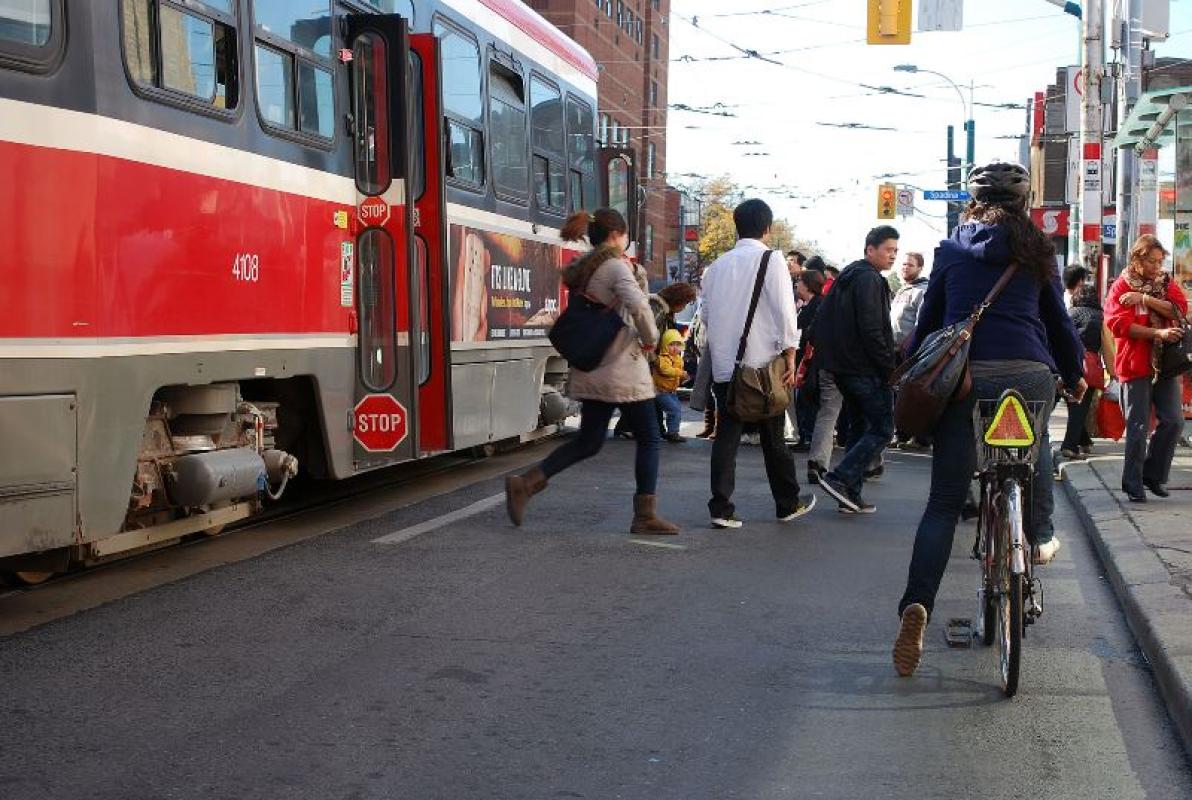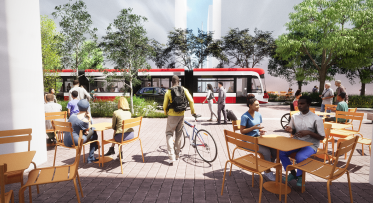Leave the Car at Home: How Employers Can Lead the Charge Toward a More Sustainable Commute
It’s not just good for the environment – riding public transit, walking or cycling to work saves money and makes you healthier.
POSTED: JUNE 10, 2014
BY: CHRISTOPHER MCKINNON
It’s no secret that the Greater Toronto-Hamilton Area (GTHA) has a traffic congestion problem, as any of the drivers among us will attest. But while we are hotly debating which roadways to repair, which transit lines to build and where to put new bike lanes, it’s a good idea to take a look at where we’re going as a city and as a region.
Out of the more than three million commuter trips in the GTHA each morning, about 13 per cent of them, or 425,000, are going into Toronto’s downtown. Growth projections for the next two decades suggest that by 2031 the number of people that make that particular commute will grow by as much as 200,000. Now consider that our current roadways are at capacity and have been for decades (hence the congestion). Also consider that each new lane we add to our existing highways can only process about 2,000 cars an hour and that the average car in the GTHA carries about 1.2 passengers. In light of these facts, one thing becomes dramatically clear: To move those 200,000 additional people in and out of the city during the morning and afternoon rush, we’d need the equivalent of twenty new two-lane highways running into the heart of the city. That’s neither practical nor very cost-effective when it comes to spending our tax dollars. In the future it simply won’t be possible for most of us to drive a car to work every morning, which is why this is something that Toronto-based employers should be thinking about.
If we want our cities to remain great places to live and work, we’re going to need to move a lot more people, a lot more efficiently. Luckily, encouraging your employees to “ditch the car” has far-reaching benefits for your employees, for your company and for the city as a whole.
Public transit, walking and cycling: Good for you, good for the bottom line
There are plenty of environmental reasons to make the shift, but getting your people out of their cars also helps your company’s bottom line and your employees’ wallets. Walking, cycling and public transit are all cheaper transportation options than owning and driving a personal vehicle. The money saved on gas, insurance and parking fees alone will make a huge difference. Companies with a high proportion of employees using public transit spend less on business travel costs. Public transit permits you to get some rest (or get some work done) en-route to the office, which boosts your productivity. The exercise of walking or cycling to work contributes to your overall health, decreasing risk of chronic conditions like heart disease, diabetes and cancer. This in turn has a variety of benefits for employers, through decreased absenteeism, fewer instances of medical leave and improved mental health. Getting twenty minutes of moderate to vigorous exercise – for example, by making your 6-kilometre commute to work by bicycle – helps to sharpen the mind and gives you an endorphin boost that can have a positive effect on your mood. The average distance of drivers’ morning commute in the GTHA is 7.2km, which translates into a cycling trip of about 30 minutes or less. How long is your commute? Maybe this summer is the time to try taking your bike to work?
There are plenty of positives to taking public transit or cycling, but maybe the most compelling is this: Studies show that the stress of driving to work – especially in congested urban centres like Toronto – contributes to negative effects on “blood pressure, mood, frustration tolerance, illness occasions, work absences, job stability and overall life satisfaction,” as noted in this report from the Ontario College of Family Physicians. Even with a similar length of commute, people that ride public transit, walk or cycle simply don’t experience the same negative effects as drivers. Put that together with the wider benefits for the community, including easing that same traffic congestion, reducing noise pollution and cutting exhaust emissions – all beneficial for the environment and the health of our communities – and it shouldn’t be a surprise that cities like Toronto and Hamilton find it’s in the interest of public health and our economic competitiveness to encourage more public transit use, more walking and more cycling.
So, how are we doing?
Across the Greater Toronto-Hamilton Area, most of our trips are still being made by car. In 2011, the most recent year where we have comprehensive data, 78 per cent of all trips in the GTHA were made with a personal automobile, 15 per cent were made on public transit and six per cent by walking and cycling combined – and this regional average hasn’t changed all that much since 1996. But if you slice the pie to look at just those who are commuting into Downtown Toronto each morning (for work or for school), you see a different story – one that underscores the changing nature of commuting in large, urbanized areas.

Figure 1 – Commuting into downtown Toronto over the past three decades. As the number of drivers remains roughly static, public transit use, cycling and walking show a dramatic upward trend. (Data source: Transportation Tomorrow Survey)
Over the last three decades, about 100,000 more people began commuting into Toronto’s downtown each morning, but the number of drivers has remained relatively static. All those new commuters are working the jobs that are fuelling the city’s economic growth,and they’re taking public transit and, increasingly, walking and cycling to get to work. Public transit now makes up 63 per cent of commutes into the downtown. Walking and cycling account for another nine per cent. The trend will continue – it has to if we hope to accommodate another 200,000 people making this trip every day – and even further underscores the need to focus our efforts on creating efficient, sustainable transportation options.
We all have a part to play, but employers especially can create incentives that help make it easier for their employees to make the switch. For example, Waterfront Toronto does a number of things to help encourage sustainable transportation and discourage personal car use. The location of our headquarters was consciously chosen to be near a public transit hub (and the waterfront, of course). Staff use TTC tokens or a car-sharing membership for daytime business travel to off-site meetings. We’ve even begun providing access to a shower and changing area for the growing number of our team that cycle or run to work. The result is that relatively few of our employees choose to drive to work each day.

Figure 2 – Employers can play a role in shifting commuting behaviour, by creating incentives and disincentives that encourage employees to leave the care at home. As a result our efforts, Waterfront Toronto’s employees tend to drive less to get to work. (Data source: Transportation Tomorrow Survey)
What can employers do to get people out of their cars
Employers can do plenty to help their employees make the shift to healthier and more sustainable modes of transportation. Here’s a list of some of the ways you can help your team ditch the car:
- Lead by example – Executives can take public transit too! At Waterfront Toronto, out of our senior management team of six, three are daily public transit riders, one (our CEO!) walks to work and two drive (though one of these executives is a sometimes cyclist). Ensuring your management team practices what they preach can help you build a work culture thatvalues healthy and sustainable modes of transport.
- Offer Bike-Sharing or Car-Sharing Memberships for Business Travel – Purchasing car-sharing or bike-sharing memberships for your employees to travel to off-site meetings can save money over frequent taxis. A side benefit for employees is that the membership fee has been paid, permitting them to use the membership for their personal travel as well and making them less reliant on use of a personal vehicle even when they’re not at work.
- Secure Bike Storage Facilities – Providing a secure place to lock up bicycles during the work day will give your employees piece of mind, knowing their ride is safe from bike thieves.
- Make Showers and Change Rooms Available – A place to clean up and change into work-appropriate clothing is essential in the hot summer months for any employees who are running or cycling to the office. This also makes it easier for your employees to fit in some exercise during the lunch hour – another great way to help your team get happier and healthier!
- Organize Carpooling & Carpooling to Commuter Rail – Employers can help match up drivers and passengers to save money and take advantage of HOV lanes, for those that must commute by car. Even better, your employer may be able to help coordinate carpooling to the nearest commuter rail station. The result is fewer cars on the road and fewer carbon emissions from personal vehicles.
- Location, location, location – Big corporations are relocating to downtown areas that are well-served by public transit, walking and cycling infrastructure. It gives their employees more viable options to get to work than their old suburban office parks – and many employees are choosing to live downtown as well, in walkable neighbourhoods, where they don’t need a car to get around. It’s more expensive to live and work downtown, but the extra expense is often offset by reduced transportation costs and a host of other benefits that come with locating in dense, walkable, mixed-use neighbourhoods.
- Provide Flexible Work Hours, Time Shifted Work Hours and Telecommuting Options – Now that we all have cell phones, computers at home, tablets and access to many of our files and office tools in the cloud, many employers are making office hours flexible, allowing their employees to commute at off-peak time or even to work from home once or twice a week, eliminating the commute entirely.
What do you think – what else can employers do to help get their employees out of their cars? Join the conversation and share your thoughts and suggestions with us on Twitter (@WaterfrontTO) and Facebook.




